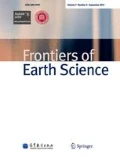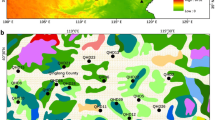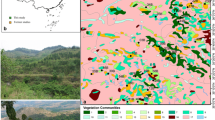Abstract
Pollen productivity is a critical parameter in the interpretation of pollen-vegetation relationships, and in the quantitative reconstructions of past vegetation from fossil pollen records. One-year monitoring records were collected for 143 pollen traps in various parts of northern China, together with modern vegetation data. Absolute Pollen Productivity Estimates (APPE) were calculated for 11 taxa using the ratio of pollen influx to plant coverage at each applicable sampling site, in which the plants of the target taxon were present. Relative Pollen Productivity Estimates (RPPE) were calculated for the 11 taxa (taking Poaceae as the reference taxon) at those sites in which each taxon occurred together with Poaceae. Artemisia and Chenopodiaceae were found to have the highest RPPEs and the largest RPPEs ranges, while Pinus and Quercus also had higher RPPEs than Poaceae; Abies, Betula, Larix, Picea and Cyperaceae had relatively low RPPEs. Variations in RPPE between different areas may be explained by variations in climatic conditions, plant coverage and land use practices which might influence plant growing situation. Marked effect that variations in pollen productivity can have on vegetation reconstructions was demonstrated by applying these distinct RPPEs to reconstructions of Holocene vegetation in the Lake Daihai area (northern China), such as a large range of RPPE produces a large range of plant coverage. Variations in RPPEs within a single taxon, related to vegetation coverage and climatic conditions, therefore need to be considered in future vegetation reconstructions.
Similar content being viewed by others
References
Andersen S T (1974). Wind conditions and pollen deposition in a mixed deciduous forest II Seasonal and annual pollen deposition 1967–1972. Grana, 14(2–3): 64–77
Autio J, Hicks S (2004). Annual variations in pollen deposition and meteorological conditions on the fell Aakenustunturi in northern Finland: potential for using fossil pollen as a climate proxy. Grana, 43 (1): 31–17
Baker A G, Zimny M, Keczyński A, Bhagwat S A, Willis K J, Latalowa M (2016). Pollen productivity estimates from old-growth forest strongly differ from those obtained in cultural landscapes: evidence from the Bialowieza National Park Poland. Holocene, 26(1): 80–92
Breiman L, Friedman J H, Olshen RA, Stone C G (2015). Classification and regression trees. Belmont, California: Wadsworth International Group. Ency Ecology, 57(1): 582–588
Broström A, Sugita S, Gaillard M J (2004). Pollen productivity estimates for the reconstruction of past vegetation cover in the cultural landscape of southern Sweden. Holocene, 14(3): 368–381
Broström A, Nielsen A B, Gaillard M J, Hjelle K, Mazier F, Binney H, Bunting J, Fyfe R, Meltsov V, Poska A, Räsänen S, Soepboer W, von Stedingk H, Suutari H, Sugita S (2008). Pollen productivity estimates of key European plant taxa for quantitative reconstruction of past vegetation: a review. Veg Hist Archaeobot, 17(5): 461–478
Bunting M J, Gaillard M J, Sugita S, Middleton R, Broström A (2004). Vegetation structure and pollen source area. Holocene, 14(5): 651–660
Bunting M J, Armitage R, Binney H A, Waller M (2005). Estimates of ‘relative pollen productivity’ and ‘relevant source area of pollen’ for major tree taxa in two Norfolk (UK) woodlands. Holocene, 15(3): 459–465
Bunting M J, Hjelle K L (2010). Effect of vegetation data collection strategies on estimates of relevant source area of pollen (RSAP) and relative pollen productivity estimates (relative PPE) for non-arboreal taxa. Veg Hist Archaeobot, 19(4): 365–374
Bunting M J, Schofield J E, Edwards K J (2013). Estimates of relative pollen productivity (RPP) for selected taxa from southern Greenland: a pragmatic solution. Rev Palaeobot Palynol, 190: 66–74
Calcote R (1995). Pollen source area and pollen productivity: evidence from forest hollows. J Ecol, 83(4): 591–602
Cao X Y, Tian F, Li F, Gaillard M J, Rudaya N, Herzschuh U (2019). Pollen-based quantitative land-cover reconstruction for northern Asia during the last 40 ka cal BP. Clim Past, 15: 1503–1536
Chen H, Xu Q H, Zhang S R, Sun Y H, Wang M, Zhou Z Z (2019). Relative pollen productivity estimates of subtropical evergreen and deciduous broadleaved mixed forest in Ta-pieh Mountains. Quat Sci, 39(2): 469–482
Cresswell J E, Hagen C, Woolnough J M (2011). Attributes of individual flowers of Brassica napus L are affected by defoliation but not by intraspecific competition. Ann Bot, 88: 111–117
Dahlström A (2008). Grazing dynamics at different spatial and temporal scales: examples from the Swedish historical record A. D. 1620–1850. Veg Hist Archaeobot, 17(5): 563–572
Gao Z Z, Dai F H (1988). Vegetation of Ningxia. Yinchuan: Ningxia Renmin Press, 52–61 (in Chinese)
Ge Y W, Li Y C, Li Y, Yang X L, Zhang R C, Xu Q H (2015). Relevant source area of pollen and relative pollen productivity estimates in Bashang steppe. Quat Sci, 35(4): 934–945
Grindean R, Nielsen A B, Tanţău I, Feurdean A (2019). Relative pollen productivity estimates in the forest steppe landscape of southeastern Romania. Rev Palaeobot Palynol, 264: 54–63
Groenman-van Waateringe W (1993). The effects of grazing on the pollen production of grasses. Veg Hist Archaeobot, 2(3): 157–162
Gunin P D (1999). Vegetation dynamics of Mongolia. Geobotany, 26
Han Y, Liu H Y, Hao Q, Liu X, Guo W C, Shangguan H (2017). More reliable pollen productivity estimates and relative source area of pollen in a forest-steppe ecotone with improved vegetation survey. Holocene, 27(10): 1567–1577
Hättestrand M, Jensen C, Hallsdóttir M, Vorren K D (2008). Modern pollen accumulation rates at the north-western fringe of the European boreal forest. Rev Palaeobot Palynol, 151(3–4): 90–109
Hellman S, Gaillard M J, Broström A, Sugita S (2008a). The REVEALS model a new tool to estimate past regional plant abundance from pollen data in large lakes: validation in southern Sweden. J Quat Sci, 23(1): 21–42
Hellman S, Gaillard M J, Broström A, Sugita S (2008b). Effects of the sampling design and selection of parameter values on pollen-based quantitative reconstructions of regional vegetation: a case study in southern Sweden using the REVEALS model. Veg Hist Archaeobot, 17(5): 445–459
Herzschuh U, Kürschner H, Ma Y Z (2003). The surface pollen and relative pollen production of the desert vegetation of the Alashan Plateau western Inner Mongolia. Chin Sci Bull, 48(14): 1488–1493
Herzschuh U, Kürschner H, Battarbee R, Holmes J (2006a). Desert plant pollen production and a 160-year record of vegetation and climate change on the Alashan Plateau NW China. Veg Hist Archaeobot, 15 (3): 181–190
Herzschuh U, Winter K, Wünnemann B, Li S J (2006b). A general cooling trend on the central Tibetan Plateau throughout the Holocene recorded by the Lake Zigetang pollen spectra. Quat Int, 154–155: 113–121
Hicks S, Helander M, Heino S (1994). Birch pollen production transport and deposition for the period 1984–1993 at Kevo northernmost Finland. Aerobiologia, 10(2–3): 183–191
Hicks S (2001). The use of annual arboreal pollen deposition values for delimiting tree-lines in the landscape and exploring models of pollen dispersal. Rev Palaeobot Palynol, 117(1–3): 1–29
How F C (1998). A Dictionary of the Families and Genera of Chinese Seed Plants. 2nd ed. Beijing: Science Press (in Chinese)
Inner Mongolia and Ningxia Research Group of Chinese Academy of Sciences (1985). Vegetation of Inner Mongolia. Beijing: Science Press, 427–641 (in Chinese)
Jackson S T, Kearsley J B (1998). Quantitative representation of local forest composition in forest-floor pollen assemblages. J Ecol, 86(3): 474–490
Li F R, Gaillard M J, Sugita S, Mazier F, Xu Q H, Zhou Z Z, Zhang Y Y, Li Y C, Laffly D (2017a). Relative pollen productivity estimates for major plant taxa of cultural landscapes in central eastern China. Veg Hist Archaeobot, 26(6): 587–605
Li F R, Gaillard M J, Cao X Y, Herzschuh U, Sugita S, Tarasov P E, Wagner M K, Xu Q H, Ni J, Wang W M, Zhao Y, An C B, Beusen A H W, Chen F H, Feng Z D, Klein Goldewijk CG M, Huang X Z, Li Y C, Jia X (2020). Towards quantification of Holocene anthropogenic land-cover change in temperate China: a review in the light of pollen-based REVEALS reconstructions of regional plant cover. Earth Sci Rev, 203: 103–119
Li Y C, Xu Q H, Wang X L, Cao X Y (2008). Modern pollen assemblages of the forest communities and their relationships with vegetation and climate in northern China. Acta Geogr Sin, 63(9): 945–957 (in Chinese)
Li Y C, Bunting M J, Xu Q H, Jiang S X, Ding W, Hun L Y (2011). Pollen-vegetation-climate relationships in some desert and desert-steppe communities in northern China. Holocene, 21(6): 997–1010
Li Y, Ge Y, Bunting M J, Zhang Z, Li J, Wang C, Li B, Li C (2017b). Relative pollen productivities and relevant source area of pollen in the forest-steppe ecotone of northern China. Rev Palaeobot Palynol, 224: 1–12
Li Y, Nielsen A B, Zhao X, Shan L, Wang S, Wu J, Zhou L (2015). Pollen production estimates (PPEs) and fall speeds for major tree taxa and relevant source areas of pollen (RSAP) in Changbai Mountain northeastern China. Rev Palaeobot Palynol, 216: 92–100
Liu H Y, Cui H T, Pott R, Speier M (1999). The surface pollen of the woodland-steppe ecotone in southeastern Inner Mongolia, China. Rev Palaeobot Palynol, 105(3–4): 237–250
Ma Y Z, Liu K B, Feng Z D, Sang Y L, Wang W, Sun A Z (2008). A survey of modern pollen and vegetation along a south-north transect in Mongolia. J Biogeogr, 35(8): 1512–1532
Mazier F, Brostöm A, Gaillard M J, Sugita S, Vittoz P, Buttler A (2008). Pollen productivity estimates and relevant source area of pollen for selected plant taxa in a pasture woodland landscape of the Jura Mountains (Switzerland). Veg Hist Archaeobot, 17: 479–495
McLauchlan KK, Barnes C S, Craine J M (2011). Interannual variability of pollen productivity and transport in mid-north America from 1997 to 2009. Aerobiologia, 27(3): 181–189
Nielsen A B, Odgaard B V (2010). Quantitative landscape dynamics in Denmark through the last three millennia based on the Landscape Reconstruction Algorithm approach. Veg Hist Archaeobot, 19(4): 375–387
Niemeyer B, Klemm J, Pestryakova L A, Herzschuh U (2015). Relative pollen productivity estimates for common taxa of the northern Siberian Arctic. Rev Palaeobot Palynol, 221: 71–82
Pardoe H S (2001). The representation of taxa in surface pollen spectra on alpine and sub-alpine glacier forelands in southern Norway. Rev Palaeobot Palynol, 117(1–3): 63–78
Pérez C F, Latorre F, Stutz S, Pastorino S (2009). A two-year report of pollen influx into Tauber traps in MarChiquita coastal lagoon Buenos Aires Argentina. Aerobiologia, 25(3): 167–181
Poska A, Meltsov V, Sugita S, Vassiljev J (2011). Relative pollen productivity estimates of major anemophilous taxa and relevant source area of pollen in a cultural landscape of the hemi-boreal forest zone (Estonia). Rev Palaeobot Palynol, 167(1–2): 30–39
Räsänen S, Suutari H, Nielsen A B (2007). A step further towards quantitative reconstruction of past vegetation in Fennoscandian boreal forests: pollen productivity estimates for six dominant taxa. Rev Palaeobot Palynol, 146(1–4): 208–220
Saito H, Mishima Y, Nogawa S, Takeoka M (1984). Pollen production rates in 75-year-old Japanese pine forest. Scientific Report of Kyoto Prefectural University. Agriculture, 36: 9–18
Schofield J E, Edwards K J, McMullen J A (2007). Modern pollenvegetation relationships in subarctic southern Greenland and the interpretation of fossil pollen data from the Norse landnam. J Biogeogr, 34(3): 473–488
Sjögren P, van Leeuwen J F N, van der Knaap W O, van der Borg K (2006). The effect of climate variability on pollen productivity AD 1975–2000 recorded in a Sphagnum peat hummock. Holocene, 16 (2): 277–286
Sjögren P, van der Knaap W O, Huusko A, van Leeuwen J F N (2008). Pollen productivity dispersal and correction factors for major tree taxa in the Swiss Alps based on pollen-trap results. Rev Palaeobot Palynol, 152(3–4): 200–210
Soepboer W, Sugita S, Lotter A F, van Leeuwen J F N, van der Knaap W O (2007). Pollen productivity estimates for quantitative reconstruction of vegetation cover on the Swiss Plateau. Holocene, 17(1): 65–77
Soepboer W, Sugita S, Lotter A F (2010). Regional vegetation-cover changes on the Swiss Plateau during the past two millennia: a pollen-based reconstruction using the REVEALS model. Quat Sci Rev, 29 (3–4): 472–483
Sugita S (1993). A model of pollen source area for an entire lake. Quat Res, 39(2): 239–244
Sugita S, Gaillard M J, Broström A (1999). Landscape openness and pollen records: a simulation approach. Holocene, 9(4): 409–421
Sugita S (2007a). Theory of quantitative reconstruction of vegetation I: pollen from large sites REVEALS regional vegetation. Holocene, 17 (2): 229–241
Sugita S (2007b). Theory of quantitative reconstruction of vegetation II: all you need is LOVE. Holocene, 17(2): 243–257
Sugita S, Parshall T, Calcote R, Walker K (2010a). Testing the landscape reconstruction algorithm for spatially explicit reconstruction of vegetation in northern Michigan and Wisconsin. Quat Res, 74(2): 289–300
Sugita S, Hicks S, Sormunen H (2010b). Absolute pollen productivity and pollen-vegetation relationships in northern Finland. J Quat Sci, 25(5): 724–736
Sun X J, Du N Q, Chen Y S, Gu Z Y, Liu J Q, Yuan B Y (1993). Holocene palynological records in Lake Selincuo, Northern Xizang. Journal of Integrative Plant Biology, 35: 943–950 (in Chinese)
Tian F, Xu Q H, Li Y C, Cao X Y, Wang X L, Zhang L Y (2008). Pollen assemblage characteristics of lakes in the monsoon fringe area of China. Chin Sci Bull, 53(21): 3354–3363
Tian F (2010). Pollen sedimentary processes of different lakes in Northern China. Dissertation for Master’s Degree. Shijiazhuang: Hebei Normal University China (in Chinese)
Trondman A K, Gaillard M J, Mazier F, Sugita S, Fyfe R, Nielsen A B, Twiddle C, Barratt P, Birks H J B, Bjune A E, Björkman L, Broström A, Caseldine C, David R, Dodson J, Dörfler W, Fischer E, van Geel B, Giesecke T, Hultberg T, Kalnina L, Kangur M, van der Knaap P, Koff T, Kuneš P, Lagerås P, Latalowa M, Lechterbeck J, Leroyer C, Leydet M, Lindbladh M, Marquer L, Mitchell F J G, Odgaard B V, Peglar S M, Persson T, Poska A, Rösch M, Seppä H, Veski S, Wick L (2015). Pollen-based quantitative reconstructions of Holocene regional vegetation cover (plant-functional types and land-cover types) in Europe suitable for climate modelling. Glob Chang Biol, 21 (2): 676–697
van der Knaap W O, van Leeuwen J F N, Svitavská-Svobodová H, Pidek I A, Kvavadze E, Chichinadze M, Giesecke T, Kaszewski B W, Oberli F, Kalnina L, Pardoe H S, Tinner W, Ammann B (2010). Annual pollen traps reveal the complexity of climatic control on pollen productivity in Europe and the Caucasus. Veg Hist Archaeobot, 19(4): 285–307
von Stedingk H, Fyfe R, Allard A (2008). Pollen productivity estimates from the forest—tundra ecotone in west-central Sweden: implications for vegetation reconstruction at the limits of the boreal forest. Holocene, 18: 323–332
Wang Y B, Herzschuh U (2011). Reassessment of Holocene vegetation change on the upper Tibetan Plateau using the pollen-based REVEALS model. Rev Palaeobot Palynol, 168(1): 31–40
Wang S M, Yu Y S, Wu R J, Feng M (1990). The Daihai Lake: Environment Evolution and Climate Change. Hefei: University of Science and Technology of China Press (in Chinese)
Watrin J, Lézine A M, Gajewski K, Vincens A (2007). Pollen-plant-climate relationships in sub-Saharan Africa. J Biogeogr, 34(3): 489–499
Wei H C, Ma H Z, Zheng Z, Pan A D, Huang K Y (2011). Modern pollen assemblages of surface samples and their relationships to vegetation and climate in the northeastern Qinghai-Tibetan Plateau China. Rev Palaeobot Palynol, 163(3–4): 237–246
Wu J, Liu Q, Chu G Q, Wang L, Liu J Q (2016). Vegetation history and climate change recorded by stomata evidence during the late glacial in the Great Khingan Mountain Region Northeastern China. Chin Sci Bull, 61(36): 3940–3945 (in Chinese)
Wu Z (1980). Vegetation of China. Beijing: Science Press (in Chinese)
Xiao J L, Xu Q H, Nakamura T, Yang X L, Liang W D, Inouchi Y (2004). Holocene vegetation variation in the Daihai Lake region of north-central China: a direct indication of the Asian monsoon climatic history. Quat Sci Rev, 23(14–15): 1669–1679
Xu Q H, Li Y C, Yang X L, Xiao J L, Liang W D, Peng Y J (2005). Source and distribution of pollen in the surface sediment of Daihai Lake inner Mongolia. Quat Int, 136(1): 33–45
Xu Q H, Li Y C, Zhou L P, Li Y Y, Zhang Z Q, Lin F Y (2007). Pollen flux and vertical dispersion in coniferous and deciduous broadleaved mixed forest in the Changbai Mountains. Chin Sci Bull, 52(11): 1540–1544
Xu Q H, Li Y C, Tian F, Cao X Y, Yang X L (2009). Pollen assemblages of tauber traps and surface soil samples in steppe areas of China and their relationships with vegetation and climate. Rev Palaeobot Palynol, 153(1–2): 86–101
Xu Q H, Tian F, Bunting M J, Li Y C, Ding W, Cao X Y, He Z (2012). Pollen source areas of lakes with inflowing rivers: modern pollen influx data from Lake Baiyangdian China. Quat Sci Rev, 37: 81–91
Xu Q H, Cao X Y, Tian F, Zhang S R, Li Y C, Li M Y, Li J, Liu Y, Liang J (2014). Relative pollen productivities of typical steppe species in northern China and their potential in past vegetation reconstruction. Sci China Earth Sci, 57(6): 1254–1266
Zhao Y, Herzschuh U (2009). Modern pollen representation of source vegetation in the Qaidam Basin and surrounding mountains northeastern Tibetan Plateau. Veg Hist Archaeobot, 18(3): 245–260
Zhu L, Lü X, Wang J, Peng P, Kasper T, Daut G, Haberzettl T, Frenzel P, Li Q, Yang R, Schwalb A, Mäusbacher R (2015). Climate change on the Tibetan Plateau in response to shifting atmospheric circulation since the LGM. Sci Rep, 5(1): 3940–3945
Acknowledgements
This research was supported by the National Natural Science Foundation of China (Grant Nos. 41877459 and 41630753) and the CAS Pioneer Hundred Talents Program (Xianyong Cao) the German Research Foundation (DFG) (No. 41861134030). Cathy Jenks provided help with language editing.
Author information
Authors and Affiliations
Corresponding authors
Rights and permissions
About this article
Cite this article
Zhang, K., Qin, W., Tian, F. et al. Influence of plant coverage and environmental variables on pollen productivities: evidence from northern China. Front. Earth Sci. 14, 789–802 (2020). https://doi.org/10.1007/s11707-020-0834-0
Received:
Accepted:
Published:
Issue Date:
DOI: https://doi.org/10.1007/s11707-020-0834-0




